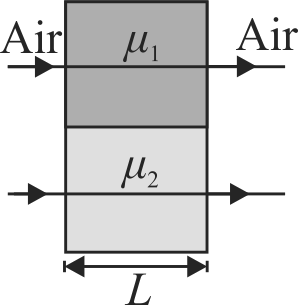367775
Two light rays initially in same phase travel through two media of equal length \(L\) having refractive index \({\mu _1}\) and \({\mu _2}\) \(\left( {{\mu _1} > {\mu _2}} \right)\) as shown in the figure. If the wavelength of light ray in air is \(\lambda \), the phase difference of the emerging rays is given by
367775
Two light rays initially in same phase travel through two media of equal length \(L\) having refractive index \({\mu _1}\) and \({\mu _2}\) \(\left( {{\mu _1} > {\mu _2}} \right)\) as shown in the figure. If the wavelength of light ray in air is \(\lambda \), the phase difference of the emerging rays is given by
367775
Two light rays initially in same phase travel through two media of equal length \(L\) having refractive index \({\mu _1}\) and \({\mu _2}\) \(\left( {{\mu _1} > {\mu _2}} \right)\) as shown in the figure. If the wavelength of light ray in air is \(\lambda \), the phase difference of the emerging rays is given by
367775
Two light rays initially in same phase travel through two media of equal length \(L\) having refractive index \({\mu _1}\) and \({\mu _2}\) \(\left( {{\mu _1} > {\mu _2}} \right)\) as shown in the figure. If the wavelength of light ray in air is \(\lambda \), the phase difference of the emerging rays is given by
